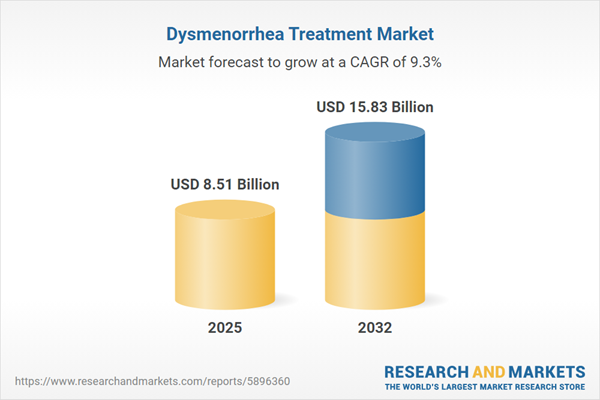Speak directly to the analyst to clarify any post sales queries you may have.
Senior healthcare leaders face a dynamic dysmenorrhea treatment market marked by major technological progress, a swiftly evolving therapeutic landscape, and higher patient expectations. Effective navigation of this market demands adaptable strategies and rigorous alignment with changing clinical standards to sustain long-term relevance and competitiveness.
Market Snapshot: Dysmenorrhea Treatment Market Overview
The dysmenorrhea treatment market is experiencing robust expansion, demonstrated by notable increases in market size and compound annual growth rate (CAGR). Strategic emphasis is placed on personalized medicine, as providers accelerate the use of targeted therapies and digital health solutions. Integrated clinical platforms and digital care models facilitate more efficient workflows, active patient engagement, and transition toward outcomes-driven care. This evolution enables organizations to address varied stakeholder needs while maintaining relevance amid rapid global innovation, especially as digital technologies become central to patient support and care delivery.
Scope & Segmentation
- Treatment Types: Diverse approaches combine non-pharmacological methods, including acupuncture, exercise, herbal supplements, heat application, and omega-3 supplementation, with conventional pharmacological therapies to enhance personalized care outcomes.
- Drug Classes: Hormonal contraceptives and NSAIDs provide both immediate and ongoing management options, supporting adaptable clinical strategies for a wide range of patient needs.
- Routes of Administration: Oral, injectable, and topical therapies enhance patient flexibility and support different care settings, from clinics and hospitals to home environments, optimizing adherence and patient choice.
- Distribution Channels: Hospitals, walk-in clinics, and digital pharmacies manage product distribution, evolving supply chains to align with modern healthcare models and reinforce system resilience.
- Applications: Solutions address primary and secondary dysmenorrhea, supporting patients with complex conditions such as comorbid endometriosis for more specialized and effective care frameworks.
- End Users: Clinics, hospitals, specialty centers, and home-based care environments ensure seamless support, aiming to improve patient experiences and clinical outcomes across the continuum of care.
- Regions: The market extends across the Americas, Europe, Middle East, Africa, Asia-Pacific, and key emerging sectors. Regional adaptation and regulatory compliance are essential for cross-border success and risk management.
- Leading Companies: Market leaders such as Bayer AG, Pfizer Inc., Johnson & Johnson Services, Novartis AG, AbbVie Inc., Merck & Co., Sanofi S.A., GlaxoSmithKline plc, and Teva Pharmaceutical Industries Ltd. shape industry standards and drive product innovation.
Dysmenorrhea Treatment Market: Key Takeaways for Senior Decision-Makers
- Combining drug-based and non-drug therapies enables delivery of tailored care strategies that better respond to patients’ changing expectations.
- Adoption of digital health solutions, including wearables, supports individualized care pathways, proactive treatment plans, and provides critical operational insights.
- Flexible operations facilitate adaptation to shifting regulatory environments and reimbursement frameworks, reducing risk when entering new territories or responding to local healthcare shifts.
- Innovative drug delivery, through advanced systems like sustained-release or topical formulations, strengthens user convenience and supports care continuity across multiple settings.
- Collaboration among pharmaceutical, medical device, and research organizations accelerates therapy development and helps bridge existing gaps in patient care.
- An increasingly competitive environment, shaped by established and digital-first entrants, drives organizations to refine market strategies to secure resilience and a sustained market presence.
Tariff Impact: Navigating Supply Chains and Cost Pressures
Recent US tariffs on critical raw materials and excipients are introducing greater variability into dysmenorrhea treatment supply chains. Organizations are responding by diversifying supplier partnerships, focusing on local sourcing strategies, and engaging with payers to address rising operational costs. Advances in drug delivery technology further support consistent patient access and help control costs amid evolving global and regulatory pressures.
Methodology & Data Sources
This research leverages a comprehensive literature review, regulatory analysis, and insights from leading gynecology experts and clinical providers. Each stage includes a detailed thematic and ethical review to ensure applicability and reliability for executive-level decision-making.
Why This Report Matters
- Provides actionable, data-driven guidance for investments in innovative dysmenorrhea therapies and digital transformation strategies.
- Supports organizations in anticipating regulatory shifts and mitigating supply chain risks for enhanced operational resilience.
- Highlights critical challenges and uncovers areas for growth across both traditional and digital healthcare models.
Conclusion
With increasing digital integration and patient-focused strategies transforming dysmenorrhea care, aligning organizational strategy with these market trends positions companies to deliver effective treatment and secure enduring competitive advantage.
Additional Product Information:
- Purchase of this report includes 1 year online access with quarterly updates.
- This report can be updated on request. Please contact our Customer Experience team using the Ask a Question widget on our website.
Table of Contents
3. Executive Summary
4. Market Overview
7. Cumulative Impact of Artificial Intelligence 2025
Companies Mentioned
The companies profiled in this Dysmenorrhea Treatment market report include:- Bayer AG
- Pfizer Inc.
- Johnson & Johnson Services, Inc.
- Novartis AG
- AbbVie Inc.
- Merck & Co., Inc.
- Sanofi S.A.
- GlaxoSmithKline PLC
- Teva Pharmaceutical Industries Ltd.
Table Information
| Report Attribute | Details |
|---|---|
| No. of Pages | 197 |
| Published | November 2025 |
| Forecast Period | 2025 - 2032 |
| Estimated Market Value ( USD | $ 8.51 Billion |
| Forecasted Market Value ( USD | $ 15.83 Billion |
| Compound Annual Growth Rate | 9.2% |
| Regions Covered | Global |
| No. of Companies Mentioned | 10 |









